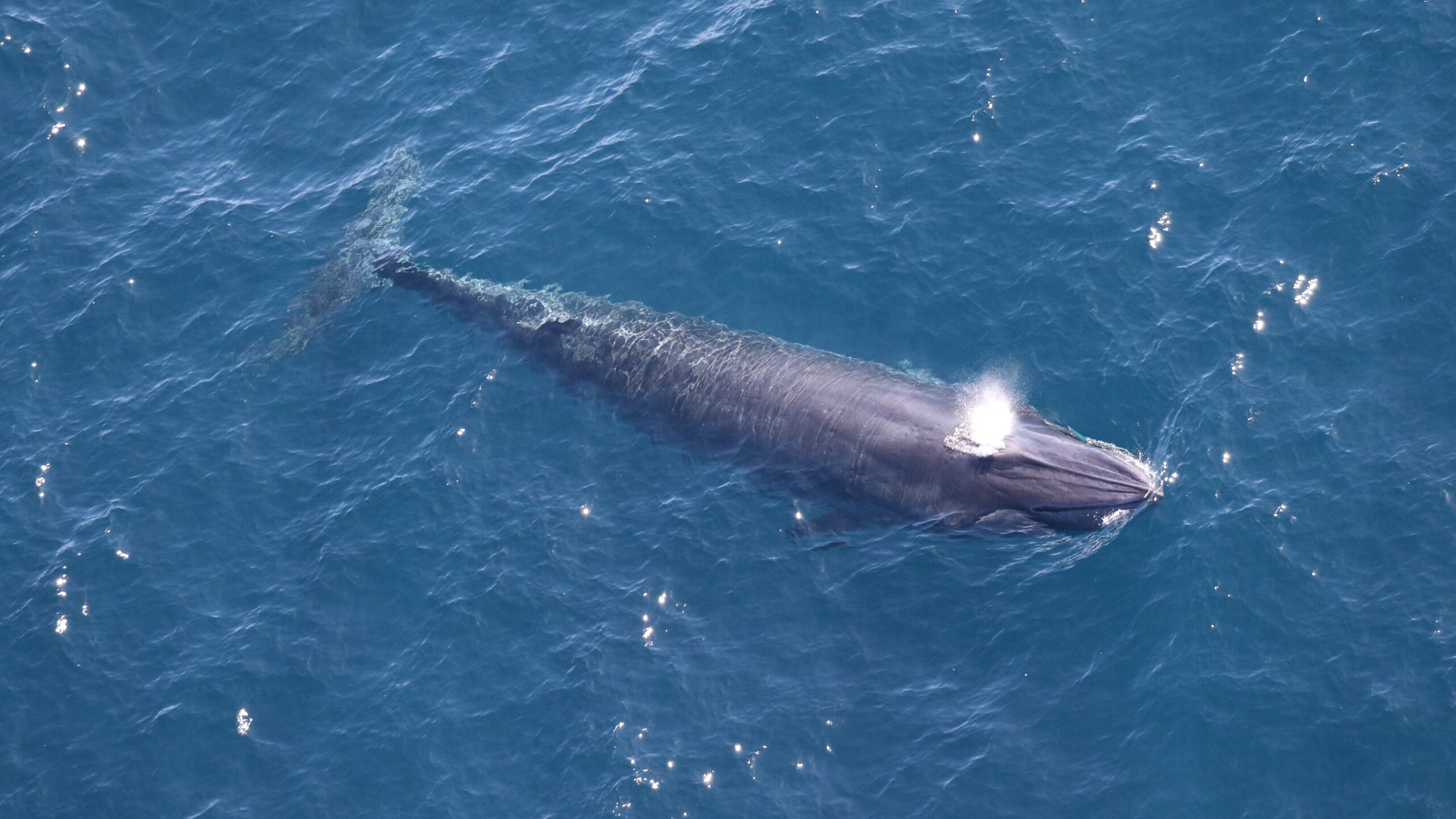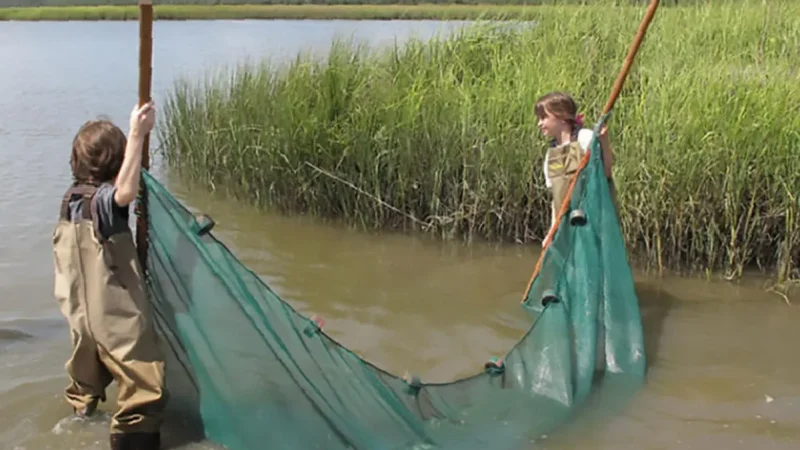The Gulf of Mexico is haunted by a ghost. The animal is as big as a school bus but glides unseen through the ocean’s twilight zone, its low moans echoing in the dim water. A creature so elusive, researchers can spend days searching without ever glimpsing one.
This is the Rice’s whale, one of the Gulf of Mexico’s largest and most mysterious animals. Found nowhere else on Earth, it is the only baleen whale that lives in the Gulf yearround.
Previously thought to be a sub-species of the Bryde’s whale, the Rice’s whale was only declared a unique species in 2021. Yet experts fear it could disappear before people ever get to know it. NOAA Fisheries researchers estimate that fewer than 100 Rice’s whales remain in the Gulf, with recent counts putting that number as low as 50.
“Our scientists have not been seeing many calves when they do surveys for Rice’s whales, which is obviously problematic,” NOAA Fisheries Southeast Large Whale Recovery Coordinator Clay George said.
NOAA Fisheries was to publish a new critical habitat designation for the species this week under a settlement agreement with environmental organizations to better protect the endangered whale.. But the parties have agreed to extend the deadline to no later than Dec. 2.
The designation means federal agencies would have to consult with NOAA Fisheries before any activity that could change or harm Rice’s whale habitat. Required under the Endangered Species Act, the rule wouldn’t create protected areas or restrictions, George said, but serve as a baseline for those conservation measures in the future.
“It essentially creates an extra layer of review for us to consider impacts to the whales’ habitat,” he said.
The proposed critical habitat designation follows the continental shelf from the Florida Keys to Texas’ southern border, though the final rule may reflect changes to this range. Unfortunately for the Rice’s whale, its Gulf home is also a major focus of the gas and oil industry.

Deepwater Horizon and industry threats
Like many researchers, Tracey Sutton was first introduced to the Rice’s whale through the Deepwater Horizon oil spill. Before 2010, little data existed on the deepest waters of the Gulf or the creatures living there.
Then on April 20, 2010, the BP-licensed Deepwater Horizon oil rig exploded. The disaster killed 11 workers and leached 134 million gallons of oil into the Gulf, making it the largest oil spill ever recorded in U.S. history
The spill had catastrophic effects on Gulf ecosystems, saturating shorelines and causing a massive die-off of sea life. Scientists estimate that 22% of the Rice’s whale population was lost as a direct result of the spill. Fourteen years later, Rice’s whales — and other impacted species — still haven’t recovered.
“Nobody really considered the fact that we could change these deep living large ecosystems with our activity,” said Sutton, director of the NOAA DEEPEND Consortium.
For Rice’s whales, oil spills can lead to a multitude of problems. Exposure to oil can cause respiratory infections, stomach ulcers and organ failure. Indirect effects such as a loss of prey, reproductive failure and stunted growth are also concerns. Deepwater Horizon was not a one-off event; oil and gas spills are routine in the Gulf, making exposure a constant threat.
Soon after Deepwater Horizon, researchers began to look closer at the creatures of the Gulf. Experts had suspected for decades that an elusive Gulf whale, classified as a sub-species of the Bryde’s whale, was its own unique species.
Then in 2019, a deceased Bryde’s-like whale washed up in the Florida Everglades. Scientists confirmed it was genetically distinct. In 2021, the Rice’s whale was officially classified as a species and named after Dale W. Rice, the first scientist to publish evidence about the whale in 1965.
Some of the oil and gas industry’s most harmful effects to the whale are heard, not seen. Rice’s whales use low-toned calls to communicate with each other and find a mate. They also use their hearing to navigate the Gulf and find prey.
Yet the Gulf is not a quiet place. Industry uses low-frequency seismic air guns to survey for oil and gas deposits underneath the sea floor. Blasts from these airguns can reach 250 decibels, louder than a large rocket launch. During underwater surveys, the shots are fired every 10 to 12 seconds for weeks or months without ceasing.
The noise can mask the calls of Rice’s whales, reducing the distance over which they can communicate and disrupting their behavior and migration patterns. Ocean noise can also lead to chronic stress, harming reproduction and hiking the likelihood of disease.
“Industry noise completely dominates the soundscape of the entire Northern Gulf,” said Michael Jasny, director of the Marine Mammal Protection Project at the Natural Resources Defense Council.
NRDC challenges oil and gas lease sales in the Gulf of Mexico. While the oil and gas activity is one of the primary threats to Rice’s whales, holding the industry accountable is a David-and-Goliath battle, Jasny said. With 15% of all U.S. crude oil coming from the Gulf, the industry has a multibillion-dollar stake in the area.
The industry “is willing to do whatever it needs and use all of its resources to prevent meaningful changes in its activity,” Jasny said.
NRDC and partners such as Earthjustice won a short-lived victory in 2021, after suing federal agencies over Lease Sale 261, a colossal oil lease in the Gulf. The 73 million-acre oil lease overlapped with Rice’s whale habitat, which NRDC argued violated the animal’s protections under the Endangered Species Act.
In a settlement, the Biden administration excluded 6 million acres of Rice’s whale habitat from Lease 261. That action was quickly appealed by oil and gas drillers. A federal appeals court ruled last fall that the Rice’s whale habitat must be included in the sale.
“The nation’s energy, economic and security future hinges on annual lease sales in the Gulf of Mexico to secure new acreage,” National Oceanic Industries Association President Erik Milito said in a news release after the sale.
“The industry is throwing lots of money at these cases,” said Earthjustice managing attorney Steve Mashuda. “And is pursuing a strategy of trying to hold on to the status quo as long as they can.”
Vessel speed limits
At the docks of the Santa Rosa Yacht and Boat Club in Pensacola, local recreational fishing teams haul mahi-mahi and tuna off boats to be weighed. For its annual Ladies’ Tournament, the Pensacola Big Game Fishing Club sent 17 boats jetting into North Florida waters to compete. As the boats return to dock, country music blares, beer flows and the competition is friendly.

Tournament organizer Keith Johnson has spent his life fishing recreationally in the Gulf and has spotted the Rice’s whale twice. Other local fishermen have spotted the rare species — but are less likely to admit to it.
“The overall sentiment within the recreational community is not to report the sightings,” Johnson said.
This don’t-ask-don’t-tell position ramped up in April 2023, when NOAA Fisheries announced it was considering a petition filed by several environmental NGOs, including NRDC and Earthjustice. The petition would limit yearround vessel speeds to 10 knots in key Rice’s habitat, an area that stretches from near Pensacola to just south of Tampa. The original petition was later amended to apply only to vessels measuring 65 feet or longer.
The announcement caused an uproar. Environmental activists argued that the restrictions were crucial to saving the whale from extinction, while fishers and shipping companies argued the limits would decimate the Gulf’s economy.
NOAA Fisheries ultimately denied the petition in October 2023, citing the need to establish baseline conservation measures such as the critical habitat designation. Once the designation is set, environmental advocates hope to see vessel speed limits back on the table.
For the Pensacola recreational boating community, Johnson said, the original petition came like a freight train. Local fishermen felt blindsided by scientists and activists, leading to an atmosphere of polarization and resentment.
“There’s just a massive hostile attitude, but I think that’s because there has been no real attempt at stakeholder input,” Johnson said.
Recreational fishing pumps millions of dollars into local communities and attracts scores of tourists. The proposed speed limit would threaten those benefits, Johnson said, adding hours to already lengthy boat trips and making people less likely to participate in tournaments.

If a 10-knot limit is brought forward again, the Pensacola Big Game Fishing Club plans to submit a strong opposition. However, many local stakeholders are still willing to work toward a middle ground, Club President Justin Williams said.
“We just want access like everybody else,” Williams said. “There should be some kind of plan to where we could work together for everyone to have access and achieve their goals as well.”
Vessel strikes are identified as one of the greatest threats to the Rice’s whale. Blunt force trauma from a ship’s bow can kill a whale instantly, and whirring propellers can leave gashes that prove fatal over time.
The whales spend most of their lives at the top of the water column, usually resting within 50 feet of the ocean’s surface at night. This makes them difficult to see, Michael Jasny, with NRDC, said — but easy to hit. With its habitat constantly crisscrossed by boat traffic, collisions are just a matter of time.
“It’s hard to design a species that has a greater risk of being struck by ships than the Rice’s whale,” Jasny said.
Large oil tankers and cargo ships, which pose the greatest risk for Rice’s whales, should be mandated to follow a 10-knot speed limit, Jasny said. He added that there should and can be more flexibility in relation to the recreational boating community.
Large vessels can have their speed monitored by digital technologies, making it easier to enforce restrictions. Most recreational vessels, especially smaller boats, don’t have the transponders needed to track them. Instead of trying to mandate rules for the recreational community, Jasny said he supports community outreach to find a compromise.
“It’s one thing to establish regulation in the ocean,” Jasny said. “It’s another to affect change in the ocean.”
An uncertain future
While oil spills, noise and vessel strikes are immediate threats to the Rice’s whale, climate change in the Gulf could raise new pressures, said John Hildebrand, an oceanography professor at the UCSD Scripps Whale Acoustics Laboratory.
The waters of the Gulf are getting significantly warmer, at a rate faster than the rest of the global ocean. With such a small population size, the Rice’s whale is particularly vulnerable to environmental changes and habitat loss.
A changed Gulf could also limit the whale’s already scant source of prey. Whales dive deep to feed at the sea floor, expending a lot of energy to hunt favorite prey like the silver-rag driftfish. This behavior is a high-risk high-reward hunting strategy, said Florida International University marine biologist Jeremy Kiszka.
According to Kiszka’s research, the driftfish may compose up to two-thirds of the whale’s diet. As far as whales go, this makes the species a picky eater. Yet over-reliance on one type of prey in a changing environment could lead to a food shortage for the Rice’s whale.
“If your food disappears one day, that might put you in trouble,” Kiszka said.
Yet Kiszka described himself as a pragmatist. The Rice’s whale is at a high risk of extinction, he said— but it’s still possible for the species to make a comeback if humans make the right investments.

Staving off further harm from climate change ultimately means moving away from oil and gas investments in the heavily industrialized Gulf, advocates said. As Steve Mashuda from Earthjustice can attest, change won’t come easy.
In the face of a multibillion-dollar industry, 50 whales may not seem like much. Yet Mashuda believes that the clock on the oil and gas industry is running down. As the nation moves toward clean energy alternatives and the Rice’s whale becomes more well-known, he hopes the current power imbalance will shift.
“The American public writ large really loves whales,” Mashuda said. “I have some optimism.”
Humans have the power and resources to save the Rice’s whale, Mashuda said. In the meantime, the grey ghost haunts an increasingly perilous Gulf.
University of Florida journalism senior Kylie Williams is a fellow with the Florida Climate Institute, which supported reporting for this story, distributed in partnership with the Florida Climate Reporting Network.






